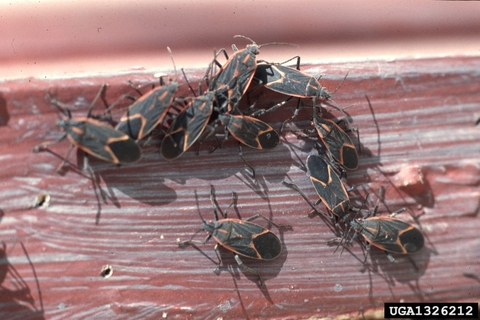As Minnesotans make the seasonal switch to sweaters and pumpkin spice lattes, insects are making a seasonal switch as well. Cooler days and especially cooler mornings send signals to certain insects: winter is coming.
The cool weather draws them from the places where they’ve been feeding on plants or on other insects to find places to ride out the winter. This often leads them to aggregate in large numbers on the sunny sides of trees, buildings and other structures.
This year’s big bug nuisance is boxelder bugs.
Boxelder bugs: Why my house, and what do they want from me?
Boxelder bug is an insect that is native to Minnesota, feeding on boxelder, maple and ash trees. Boxelder bugs tend to have high populations during hot, dry summers (records show their populations skyrocketed during the Dust Bowl in the 1930s), meaning a summer like we had can produce a lot of boxelder bugs. They are now sensing the seasons are changing, and looking for a warm place to hunker down for the winter.
Boxelder bugs are nothing more than an annoyance. They don’t cause meaningful damage to plants, trees or people, they don’t bite people, and they don’t spread disease. The worst they do is give people the heebie-jeebies, and smell a little bad when crushed.
There are a couple of reasons that boxelder bugs end up in certain spots. They love the warm sun on buildings with southern and western exposure. This is especially true if the building is the tallest thing around.
Other insects you might run into are brown marmorated stinkbug and multicolored asian ladybeetle.
Keeping the bugs on the outside of your house out of your home
The bugs are looking for somewhere warm to spend the winter. Instead of spending your energy removing bugs, allocate your energy to plugging up the cracks in your home where they can make their way inside.
- Check around window screens and doors for gaps.
- Look at areas where cords, cables, and vents leave your house and seal those areas.
Checking the exterior of your home and making it bug-proof can have other benefits. Mice only need a quarter-inch (think the size of a dime) to get into a house, so by bug-proofing your house, you can keep out pests that actually cause damage to your home.
Don't cut down your trees
Sometimes people think “I have boxelder bugs, I have boxelder trees, the trees are my problem!” Trees provide a lot of abstract and concrete benefits to people, so cutting a boxelder tree down because of a bug problem every five years isn’t a good solution.
Besides, boxelder bugs fly (though not necessarily gracefully). They can fly a few miles, so removing a tree on your property doesn’t mean you will never see another boxelder bug.
Prevention is fine, but I want them gone!
If you want a direct approach, physical removal is a good option. Grab an extension cord and your shop vac and go to town. Sucked-up bugs can be dumped in the garbage.
Think carefully before using a pesticide. Boxelder bugs may annoy you, but won’t make you, your family, your pets, or other insects sick. But the chemical you spray might.
If you are okay with the risks, choose a product carefully. This means reading the fine print, maybe a lot of it! Make sure the product you’ve pulled off the shelf says it can be used on the outside, or the exterior, of buildings.
Before you apply a pesticide, make sure you also read the product's directions around how to safely spray and what protective clothing to wear. While spraying insects in the hot afternoon sun may make you want to reach for shorts and sandals, if the label says you need sleeves, socks and long pants, you need to wear sleeves, socks and long pants.
CAUTION: Mention of a pesticide or use of a pesticide label is for educational purposes only. Always follow the pesticide label directions attached to the pesticide container you are using. Be sure that the area you wish to treat is listed on the label of the pesticide you intend to use. Remember, the label is the law.


